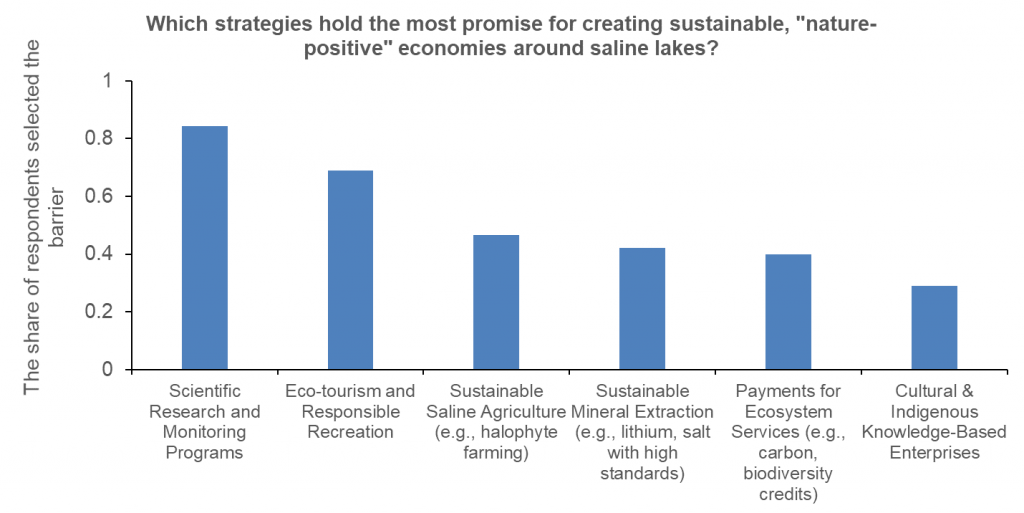Report on the Session: “The Conservation of Saline Lakes and Wetlands and Solutions for a Sustainable and Resilient Transition“
This session was held online at the IUCN World Conservation Congress (Abu Dhabi 2025), organized by members of the International Society for Salt Lake Research (ISSLR), aimed to highlight the critical role of saline ecosystems, promote nature-positive approaches, and foster global collaboration for their conservation. The format was an interactive discussion, pivoting from a planned larger audience to an intimate roundtable due to low attendance, which allowed for deep, candid conversations among experts from Australia, India, China, Nigeria, Germany, and Russia.
The session began with a presentation by Egor Zadereev (Russia), the President of ISSLR, of results from a pre-congress survey circulated among ISSLR members, primarily scientists, which revealed critical perceptions and potential gaps in the field:
- Ranked Threats: The most urgent threats to saline lakes with not clear dominance of either of them were identified as: Direct water diversion/extraction, Climate change, Pollution, Habitat fragmentation/degradation and Biological resource over-exploitation
- Significant Barriers: The most significant barrier to effective conservation was identified as a “lack of political will and governance.”
- Promising Strategies: The most promising strategy was ranked as “scientific research and monitoring programs”.



A critical disconnect was noted: while the primary barrier is political, the proposed primary solution is scientific. This highlights a gap between scientific understanding and its translation into policy and effective on-the-ground action.
The discussion was structured around two central questions, yielding the following insights:
Barriers to Allocating Water for Ecological Needs & Strategies to Overcome Them
Australia (Dr. Faith Coleman, Coorong Environmental Trust): Illustrated a “cautionary tale” where water trading schemes designed for efficiency inadvertently led to less water for the environment. A significant point was reframing climate change as the “biggest water consumer,” drastically reducing overall water availability and exacerbating competition. The strategy of simply buying back water rights from irrigators is politically unpopular, indicating a need for more nuanced solutions.
India (Dr. Seema Kulshreshtha, Govt Shakambhar PG College): Emphasized a people-centric approach, stating that conservation must focus on human wellbeing. Key barriers identified were:
- A communication gap between scientists and policymakers.
- The need to empower scientists to act as conduits of information to political leaders.
- The lack of clear land rights and management plans for many lake ecosystems.
China (Dr. Hongchen Jiang, China University of Geosciences): Provided a macro-level context, framing the challenge as a national transition from quantitative growth to qualitative, sustainable development. While discussing digital and green energy transitions broadly, it was noted that these large-scale shifts influence water demand and management for saline ecosystems.
Nigeria (Mr. Sonigitu Asibong Ekpe, Cross River State Ministry of Environment): Highlighted threats specific to coastal saline wetlands (mangroves), including invasive species (Nypa palm), pollution from shipbreaking and the oil industry, and overharvesting for firewood. Government efforts are underway, including new climate policies and international funding for integrated management.
Nature-Positive Approaches and Success Stories
Australia (Dr. Faith Coleman): Shared a success story of restoring “green carpets” of macrophytes (like stoneworts) in saline lakes by managing water sources (increasing groundwater inflow versus seawater) and excluding livestock. This led to improved water clarity, odor control, and the return of fish and thousands of birds. The key ingredient was community engagement, driven by a local fisherman’s decades-long records and passion, which bridged the gap between data and political action.
India (Dr. Seema Kulshreshtha): Cited the successful restoration of Chilika Lake. An ecosystem-based approach, including dredging, creating new sea inlets, and watershed management with strong community involvement, revived the lake’s ecosystem and local livelihoods, transforming it from a “dying lake” into a Ramsar model site.
In an informal poll, participants identified the single greatest threat and key ingredients for successful conservation:
Greatest Threat: Climate Change was voted the top threat, with the recognition that it is an overarching driver that intensifies all other pressures, particularly water scarcity.
Key Ingredients for Success: When asked for one word or phrase essential for conservation, the responses were:
- Listening (to the landscape and the community)
- A Vision (of what was lost and can be regained)
- Community Awareness & Involvement
- Incentives for stakeholders
- Enthusiasm (to drive long-term efforts)
The session concluded with a forward-looking discussion on the path ahead for saline ecosystem conservation:
- Global Commonalities: It was noted that the problems facing saline lakes (e.g., the Aral Sea, Great Salt Lake) are strikingly similar across different political and economic systems, underscoring the need for a unified global response.
- Focus on “Manageable” Systems: A strategic shift was proposed: while large, iconic lakes capture media attention, smaller and medium-sized saline ecosystems often present more tractable opportunities for successful restoration. These “lighthouse” projects can demonstrate success and build momentum.
- Broadening the Scope: The society affirmed its commitment to studying not just inland saline lakes but the entire spectrum of saline ecosystems, including coastal lagoons, wetlands, and salinas, which are at the frontline of climate change impacts like sea-level rise.
The session served as a call to action for interdisciplinary collaboration and wider engagement with the ISSLR. The importance of sharing positive stories and successful practices to inform policy and inspire action was strongly emphasized.
The session successfully provided a snapshot of the current challenges, highlighted inspiring solutions, and reinforced the critical role of bridging science, community passion, and political will to ensure the future of the world’s saline lakes and wetlands.
